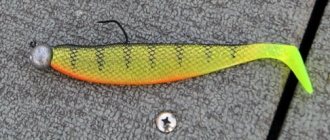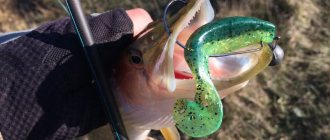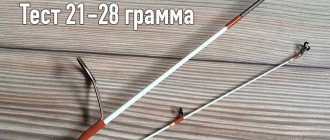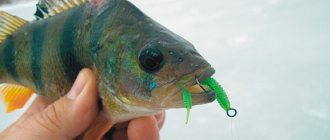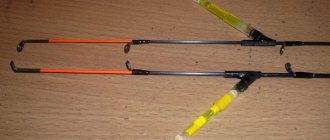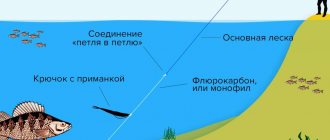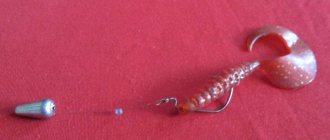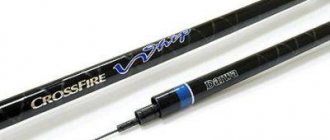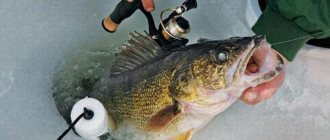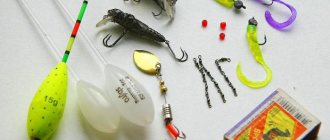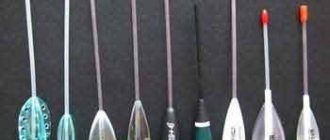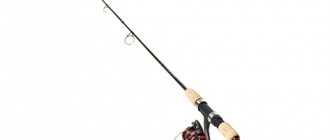Description of fishing method
It is no secret that trophy predators almost always stay in deep places at a significant distance from the shore. It is very problematic to get them from there using traditional equipment, so fishermen began to use a unique technique called “jig”, for which special jig baits are produced, consisting of two separate parts:
- The product itself.
- A jig head with a specific weight and shape.
If we are talking about fishing at impressive depths, then it is advisable to use heavy spinning baits, and lighter ones for shallow waters. As for the shape, it is chosen taking into account the nature of the bottom of the reservoir. If it is covered with a layer of silt, then a jig head with a flat base works great in such an area.
As with any other method of spinning fishing, for jig fishing it is necessary to use special wiring with the appropriate character. It is created as a result of the movements of the rod and the reeling of the fishing line. And although initially everything seems very simple and accessible, in order to acquire all the necessary skills you have to put in a lot of effort and time.
What are vibrotail and twister?
The common characteristics of both baits include the fact that both the vibrotail and the twister do not have their own loading; when fishing, they are mounted on a jig head. Functionally, they are quite different.
Thus, the twister is made of soft silicone, and vaguely resembles a worm with a peculiar spiral-shaped tail, quite large in size. When the bait moves through the water, its tail makes various oscillatory movements, attracting predatory fish.
The vibrotail is, in fact, a silicone dummy of a small fish. Like a twister, the tail part is its main functionality. The tail of the bait, otherwise called the “ripper,” is located to the “body” of the fish at a certain angle. Resisting the movement of water, it makes characteristic movements similar to the behavior of a live fish.
Choosing the right rod
The key to successful fishing is the correct choice of jig rod . This issue needs to be approached with special responsibility, because the effectiveness and comfort of fishing directly depends on it. It is important to choose those blank models that have a certain set of characteristics that correspond to the parameters of the bait. Otherwise, you will not be able to plausibly present the product to the fish and then successfully hook it. The fisherman needs to fully feel the bait, knowing when the moment of bite comes.
Among the key criteria influencing the upcoming choice are fishing conditions. You must understand that different gear with different parameters is selected for shore and boat fishing.
If we talk about fishing from a boat, then using long forms is the wrong decision, because with such a tool it will be problematic to cast and catch prey. Therefore, the ideal option is a 1.9-2.4 meter blank, which will not cause discomfort to the fisherman and interfere with the convenience of fishing.
For shore fishing, the following philosophy is used: the longer the spinning rod, the easier it will be to cast the bait over a long distance. However, along with the length, the mass of the tool also increases, so this increases the load on the hands. Also, vegetation is often present in the coastal zone, which complicates the use of long blanks. Therefore, experts recommend choosing 2.7-3-meter models, which are quite sufficient for most fishing conditions.
Spinning rod parameters
All fishing rods are conventionally divided into several categories , which are compiled depending on their nature, including action.
For a beginner jig spinner, blanks with fast or super-fast action are perfect, which will allow you to perform high-quality and reliable hooking. In addition, such inventions react more sensitively to bites, which increases the chances of performing an accurate strike at the most opportune moment.
When choosing a reliable fishing rod for fishing with a jig head for pike, perch or pike perch, pay attention to the test load indicators. They indicate the maximum weight of the bait that can be used on a particular form with the ability to control the retrieve. Currently, there are three groups of fishing rods that differ in test characteristics:
- In the first group there are models for ultralight fishing, the test of which reaches 10 grams. It is advisable to buy them when catching small predators, such as perch or pike perch.
- The second group contains forms with a test load from 10 to 30 grams. With their help, you can comfortably catch larger prey, the weight of which reaches 10 kilograms. As a rule, it is these spinning rods that are used by domestic fishermen, as they are suitable for our natural conditions.
- The third group included models with test values from 30 grams. They are especially effective for deep-sea fishing and casting jig baits for pike into remote areas of the reservoir. If you are going to fish on a river with intense currents, then this option is the most suitable.
When choosing a good spinning blank, take into account the material of manufacture. It is advisable to choose good models from trusted manufacturers, which are created on the basis of modern materials with high strength and, most importantly, low weight. However, such fishing tools are not cheap, so a beginner may find them difficult to access .
Best jig reel
When planning to assemble jig tackle with your own hands, it is also important to choose a good reel. And although high demands are not placed on this element, for comfortable fishing it is better to choose high-quality and functional solutions.
In most cases, for this direction of spinning fishing, an inertia-free model with the appropriate size is used. Today, functional multipliers are widespread, but only experienced fishermen know how to use them. Most often, multiplier products are indispensable for catching large-sized prey, for example, for catching catfish. For the average spinning player, a regular, easier-to-use, inertia-free reel will be sufficient.
Experienced fishing masters recommend giving preference to models with a characteristic spool coating. After all, if you wind expensive braid on a plastic spool, it will quickly wear out and completely fail. This is explained by certain features of the structure of the braid, which has abrasive properties. As for the classic monofilament line, it is more stable and is not afraid of such influences.
Spinning line
Many fishermen use monofilament line, proven over the years and experience, for jig fishing on small rivers and lakes, although braided line is also used quite often. However, the cost of the latest invention is very high, so not all beginners can afford to buy it. However, monofilament has significant disadvantages, including:
- Increased specific load.
- Less strength.
- The presence of a “memory effect”.
In some situations, monofilament line is more effective than the most expensive braid, so it all depends on many individual characteristics .
To choose the appropriate line option for your spinning tackle, be sure to study the fishing conditions. For long distances, braids are excellent because they more quickly transfer the moment of bite to the tip of the rod. When fishing at a short distance, monofilament is suitable, because here its stretchability practically does not affect the performance. In addition, it significantly dampens the jerks of a large predator.
Catching baits and baits
For modern jig fishing, two types of baits are used:
- Made from foam rubber.
- Silicone products.
If we talk about the first category, it includes many classic baits that are available at a low price in any fishing store. In addition, they are easy to make with your own hands, which is what experienced spinners do. In this case, it is possible to make several inexpensive devices with minimal costs.
In turn, silicone baits appeared much later, but began to rapidly gain popularity, having many advantages. There is a wide variety of silicones on sale in different sizes, colors and shapes. Due to the unique properties of silicone, manufacturers have managed to bring to the market truly catchy jig baits that perfectly imitate the play of real fish, as well as insects or any other inhabitants of the depths. To increase efficiency, flavors are added to silicone, as a result of which the number of bites increases significantly. This produces the popular edible rubber.
Also for jig fishing, combined solutions are used, which are created from old, damaged silicone baits. Due to easy processing under the influence of temperature, silicone that has become unusable quickly becomes a new, functional bait. It is enough to pick up soldering equipment, and perhaps you will be able to invent a real masterpiece.
Jig head installation
How to attach the chosen bait to a jig is a question that many beginners face. Today, several installation options are used, which are determined by the nature of the load:
- Rigid mount. It is particularly simple and uncomplicated. In this case, it is necessary to connect the jig head to the bait so that the weight is placed in front of the bait, and the point of the hook goes up.
- Flexible mount. Using this technique, you can recreate a more vivid game of the bait. The product must be put on a hook, and a weight, for example, based on Cheburashkas, must be connected to the hook using a winding ring. For equipment, both conventional hooks with a long shank and offset ones are used. The last option is effective for creating so-called non-clings.
Regardless of the installation features , it is important to choose the right hook size so that it matches the size of the bait. Very often, single hooks are replaced with doubles or treble hooks, which significantly increases fishing efficiency, but also increases the number of snags of the equipment on snags, stones and other underwater obstacles.
You can find out how to attach bait to a jig head from experienced spinning colleagues, or look it up on the Internet.
It is preferable to choose spherical products as a sinker. They are effective for any spinning fishing conditions and are affordable, while being easy for a beginner to set up. In addition to spherical products, so-called boots, or irons, are popular, which are often used for attaching vibrating tails and other small silicones.
Jig head mounting
Mounting silicone on a jig head is the easiest option for beginning spinning enthusiasts to begin mastering these baits. Few people succeed in fitting a twister or vibrating tail correctly the first time. But with each new fishing trip, the skill is honed.
Jig head and “meaty” silicone are formidable pike weapons
In general, the algorithm for installing a twister or vibrotail on a jig head is as follows: 1. Select a jig head of suitable weight;
2. The hook size is taken so that it comes out approximately in the middle of the bait;
Advice! Before installing the silicone on the jig head, you just need to attach the hook to the bait to determine if their sizes match.
3. We pierce the bait from the head part;
4. We smoothly move the hook shank towards the tail;
5. All that remains is to carefully remove the hook tip from the back of the silicone;
6. We level the bait so that it has the most realistic game in the water.
Jig heads come in different shapes and sizes. It is generally accepted that the installation described is used exclusively for pike. However, it is suitable for fishing the striped robber and the fanged inhabitant of the river depths. The advantages of such equipment include simplicity and a small number of idle bites.
The disadvantages of jig heads are:
- high grip, impossibility of use in strong places;
- low flight performance;
- due to the rigidity of the structure, if fished inappropriately, the likelihood of a predator getting off the hook increases;
- difficult to make with your own hands.
Rigid mounting on a jig head with an open hook is usually used when fishing for a predator in the water column, in shallow places with a clean bottom, along a strip of coastal algae. The best way to catch pike with this rig is to catch perch, pike perch, and, less commonly, asp and catfish.
Wiring options and technology
The success of the upcoming fishing depends on many factors. These include the skill of the spinning rod and the correct wiring. Correctly bringing the bait to the predator and then hooking it is one of the main conditions for effective fishing .
In most cases, a universal classic retrieve is used, which is created by moving the rod upwards or by periodically reeling in the fishing line. In this case, after forming the step, you should immediately remove the slack in the fishing line. If you don’t do this, you simply won’t be able to detect the bite in time.
If instead of one stroke of the rod, several shorter ones are used, then a large step is formed, into which small steps will enter. Because of this variety, the bait will play especially well, so even the most inactive fish will sooner or later react to it.
Under certain fishing conditions, there is nothing better than a uniform retrieve. This is due to the nature of the bait used. For example, if fishing is carried out using a vibrating tail, then a uniform type of fishing perfectly imitates the behavior of live prey. Sometimes it is advisable to use a slower and sometimes very aggressive retrieve to provoke the predator to attack.
Wiring for demolition is used for river fishing. In this case, the jig product is cast upstream, maintaining an angle of up to 45 degrees. The bait immediately sinks to the bottom and is then carried away by the current. With the help of small twitches of the rod, the bait is forced to supposedly bounce on the bottom, which greatly attracts the toothy hunter.
There are really many wiring methods, but which one is the most suitable is up to you to decide. The main thing is to take an experimental approach and be attentive to all aspects of the upcoming fishing. In this case, a good bite will not take long to arrive.
ribalka.guru
Characteristics and advantages of twisters and vibrotails
Depending on what type of fishing and what kind of prey you most prefer, you need to select the appropriate bait.
The twister is characterized by:
- high-amplitude game that attracts perch;
- good performance in standing waters;
- functionality at different wiring speeds (the exception is mini-twisters, which only work at a good wiring speed);
- compatible use with spinners;
- adaptability to certain types of reservoirs, stationary fishing, fishing with strong snags;
- Convenience when casting.
Features of the vibrotail:
- low amplitude of movements, attractive for pike perch and pike;
- efficient operation in strong current conditions;
- an independent bait that does not need to be equipped with spoons.
- used with jig heads;
- bright colors of the vibrotail give good results in muddy water;
- Only used for trolling fish from a boat.
As you can see, the functions of both types of baits - vibrotail and twister - are fundamentally different. Therefore, discussing which one is better to choose is not very advisable. A real fisherman must have in his arsenal the most diverse number of fishing tackles. After all, you never know when you might need them. Maybe one of these days you will go fishing with your friends to a new place, and there you will catch the fish of your dreams? Therefore, you need to be fully prepared - take both types! Have a rich catch!
TAGS:
How to fish with vibrotails
One of the most important stages when fishing with vibrotails is their equipment. And yet, how to catch pike with a vibrotail? Just like twisters, these baits can be equipped with either a regular jig head with a single hook, or with the help of an eared sinker, hingedly connected to a single, double or tee. Practice has shown that it is much more convenient and efficient to use a hinged joint. Let's try to explain why.
- Firstly, it is quite difficult to find a regular jig head with a single jig that would be well suited for equipping a vibrating tail. Today, the specifics of the fishing market are such that most of these jig heads are excellent for equipping twisters due to their relatively long body, but are poor for equipment. It usually turns out that, for example, a jig head of the required weight is equipped with such a large hook, because of which the bait will be literally paralyzed, and there will be no talk of any game. If you choose the right hook size at which this bait will play perfectly, then in the vast majority of cases it will turn out that the weight of the sinker will become insufficient.
- Secondly, as in the case of twisters, the hinged connection allows you to select a head of the desired weight in a matter of seconds and quickly equip the bait with it using a simple winding ring.
- Thirdly, the hinged connection of the sinker with the bait allows you to make longer casts.
- Fourthly, due to the additional degree of freedom, the performance of the bait is significantly improved.
- Fifthly, there is an additional possibility of choosing a hook: you can easily install a tee, a double or a single hook, or even equip the bait with several hooks at the same time.
There are other advantages of using a hinged connection between the weight and the bait over the simplest jig heads, which we will talk about a little later with detailed descriptions, photographs and visual diagrams.
Fishing with a jig head
The simplest is not always the best.
Alas, the jig head also has two serious drawbacks: firstly, only the tail of the silicone bait plays on a rigid mount, and secondly, the single hook does not detect and hold the fish well enough.
This is especially true for pike - not only does the spotted pike have a hard mouth studded with teeth, it has two long cavities in the upper jaw, covered only with thin skin, into which a single hook often falls.
Fig.3. Snatching force when fishing with hard rigs.
When fishing, the pike begins to shake its head, the hard jig head acts as a lever (Fig. 3) - the skin breaks through and the hook pops out.
There are many mishaps when catching pike perch: the fanged one can also grab the bait from any direction, sometimes with the very edge of its mouth, and sometimes it “hits with its gills.” In such cases, a single fishing rod, alas, does not always reliably detect the fish, so here too it is irrational to use a jig head, except in snaggy places or when scouting in unfamiliar waters.
Thus, it is better to use a jig head in the following cases:
In all other cases, free (hinged) equipment of jig baits is preferable.
Cloudflare Ray ID: 63a89392bdb84c31 • Your IP: 195.64.208.251 • Performance & security by Cloudflare
Cloudflare Ray ID: 63a893930a02dac0 • Your IP: 195.64.208.251 • Performance & security by Cloudflare
- thorn (needle);
- ball;
- mushroom (umbrella);
- arrow.
How to attach a vibrotail
In our opinion, the arsenal of a jig spinner must include a whole set of vibrating tails of various sizes and colors pre-equipped with hooks. As with twisters, some of the more catchy lures need to be rigged correctly or a high-end series hook with a vibrator hook will help you on days when the fish are hitting the bait but not getting caught.
We want to pay special attention to how the bait, usually articulated with an eared sinker, behaves in the water during retrieval. Most anglers who started fishing with lures using a regular jig head with a single hook were accustomed to the fact that the bait was positioned with its back up when retrieved.
When switching to an articulated joint, it turns out that the bait, under the influence of hydrodynamic forces, turns 90° in the water and moves as if lying on its side. Many people don’t like this position of the bait, and they usually act in two scenarios: they abandon the swivel joint in favor of the usual jig head with a single jig, or they try to force the bait to move with its back up, additionally loading its belly.
We tried many options for equipping vibrotails on a hook and came to the conclusion that the most effective and most attractive position for fish was the lying position on its side. In our opinion, this position of the bait during retrieving is preferable for several reasons: the action of the bait is similar to the movement of a wounded or sick fish falling on its side, the bait glides more smoothly in the water column. Taking into account this specificity, we began to equip the bait with a double, both hooks of which were specially brought out from one side. In the air, such equipment looks somewhat awkward, but in the water the bait immediately turns its hooks upward. This position is maintained throughout the entire step wiring .
Due to the orientation of the double with the tips up, the probability of a hook is significantly reduced, and the reliability of hooking even increases slightly. Just as in the case of twisters, these baits can and should be trimmed. This is especially useful for increasing casting distance. In addition to trimming, you can modify the operation of these baits by boiling them in boiling water or by melting the material.
The fact is that in general this jig bait is a rather capricious bait compared to the same twister, and sometimes you have to tinker a lot for it to work properly. But this most often, naturally, applies to these nameless lures, and not to their thoroughbred branded counterparts.
sovetprost.ru
In the world of fishing, spinning fishing with a jig head is especially popular. This method allows you to successfully catch almost any type of predatory fish, regardless of the reservoir, climate or other characteristics. Jig baits are very effective everywhere and always. They can attract potential prey from a long distance, at shallow or deep depths, in cloudy or clear weather, in the evening or in the morning, etc. Even if a fisherman is forced to cast into hard-to-reach places, covered with dense thickets of algae, with many obstacles and snags, such a bait will remain relevant there. But in order to achieve good results from the upcoming trip to the reservoir, it is important to fulfill one mandatory condition: correctly attach a vibrating tail, twister or other jig bait to the head.
Varieties of jig heads Today, the following types of jig heads for spinning fishing are widespread: - combined with a hook; -separate; The first variety is the most popular and versatile. It comes straight with a hook, so putting on the artificial fish will be much easier and faster. How to attach bait to a jig head If you are one of those anglers who often ask the question: how to properly attach bait to a jig head, you will find it useful to read this article. Such simple tips will be a good helper for successful fishing. To successfully bait your chosen bait onto a hook, you do not need to have any special experience or skills. It is enough to decide on the size of the hook. on which a silicone or foam fish will be mounted. After installing a vibrating hook, twister or other jig bait, you can take a small amount of glue and fix it near the eye of the hook with a few drops. This simple action will make the equipment more reliable and resistant to aggressive influences. We put the bait on a single hook If you need to put a jig bait on a single hook, it is important to perform the procedure in such a way that the shank goes along the center of the body. This will make its appearance more even and smooth, and accordingly the wiring efficiency will increase significantly. Incorrect baiting can seriously harm successful biting. How to put twisters, vibrotails, silicone and foam fish on a double hook? When using twisters or fish made of foam rubber and silicone, it is important to choose not classic doubles, but characteristic double hooks with an increased forearm length. Before installing the vibrating tail, you need to slightly unclench the hooks, leaving a gap of 3-5 millimeters between them. How to attach bait to a tee? If you have to mount a silicone or foam fish on a treble hook, take a special rod or tube, choose a suitable place, and make a through hole in the bait. The tee must be pulled through the hole with the eye facing forward. How to put bait on offset hooks? This type of hook is often used to create jig hooks that allow you to successfully catch predatory fish in hard-to-reach conditions. We select the optimal hook size and make a highly effective rig by bringing the offset tip closer to the back of the bait. To make sure that you managed to successfully bait an artificial fish on an offset hook with a jig head, do the following: - run your finger along the back of the bait (if everything is fine, your finger will not catch on the hook); - press on the back of the fish (if positioned correctly, it will bend); How to attach a silicone fish to a jig head? If we are talking about installing a vibrating tail, it is advisable to carry out the procedure in such a way that the hook comes out slightly from the bait on the back at the beginning of the tail, but not in the middle. The last option is incorrect, but unfortunately it is used by a significant number of novice fishermen. Because of this baiting, most bites are unsuccessful. Successful installation of a vibrating tail implies: 1. Correct choice of the place where the hook from the bait will protrude; 2. Exit the hook point from the side, near the tail. How to put twisters on a jig head? As with the previous bait, when rigging twisters, it is important that the hook comes out of the back near the tail, and not in the middle or at the rear. Select a place on the bait in advance and mark it with a puncture. The hook size must remain sufficient, otherwise the likelihood of unsuccessful bites will increase sharply. Tying the bait to the fishing line To properly tie the jig bait to the fishing line, you can use the following methods: - installation through a fastener (implies tying using the fastening method); - when using a metal leash; -direct fastening (just choose a good knot and securely fix the bait on the jig head);
If you want to get the most out of your fishing experience, it is better to purchase a full set of jig heads of different shapes and sizes in advance. In this case, you can always choose the appropriate option for the current fishing conditions.
prichal-nn.ru
How to properly attach a vibrating tail to a jig head
A regular vibrotail (ripper) does not have such a clear transition from the body to the tail as a twister does - so you need to look and determine where the body begins to taper towards the tail. When attached to a jig head, the hook is brought out into the back of the “fish” where it just begins to narrow towards the tail, or a little earlier (Fig. 1b), so as not to worsen the game. After all, it is clear that only that part of the bait that is located at the back vibrates, while the hook itself and the front part are motionless.
It is a little more difficult to attach a “skeleton” vibrotail to a jig head. It is clear that here too the hook must be brought out in the thick part of the fish’s body until the first thin bridge. The difficulty is that to improve the game, the thin foretail of some vibrotails is quite long, and the remaining short body is “not enough” for the entire length of the hook. Here you have to either look for jig heads with shorter hooks, or bend the hook yourself, reducing its length and increasing its width. If the hook is thin and not overheated, then doing this with pliers is not at all difficult.
What types are there?
All rubber nozzles can be divided into two groups:
- Passive.
- Active.
The first type does not have its own game while moving in the water column or along the bottom. All baits are of different shapes - from simple elongated rubber bands in the form of worms, to a strict outline imitating individual parts of the body of insects, crustaceans, and invertebrates. The equipment of this group includes: worms, crayfish, larvae, tadpoles, slugs, frogs, squids (tubes).
The second class has its own unique figure (body), similar to the outline of fish, and a peculiar tail. This class includes twisters and vibrotails.
Twisters have a curled tail and a flat or ribbed body. Vibrating tails are silicone baits in the shape of fish with a flat tail. Its end is located at a slight angle to the main axis of the bait or strictly perpendicular.
To animate passive worms and insects, the fisherman has to use all his imagination and unique wiring to attract the attention of the fish. And thanks to the unique shape of active rubber fish, an attractive game is achieved even during even retrieving.
The range of silicone equipment and the use of your favorite twister are not limited to the personal preferences of the fisherman. Rigging silicone baits is the main task of any angler.
Currently, 4 types of installation have gained universal recognition among spinning fishermen. Each has its own distinctive features and suitable tire model. Let's consider the specifics of equipping each separately.
Tee equipment
To equip vibrotails with triple hooks, you will need additional unpretentious equipment in the form of a metal or plastic tube with a diameter of no more than five millimeters. The length is enough to be 2 cm. The tube should be one and a half times the thickness of the silicone bait being mounted. This device is needed to make a through hole in the side of the vibrating tail body for mounting a tee.
Important! The hole should be optimal in diameter based on the size of the tee. A small hole will not allow symmetrical installation of the tee hooks, and a large hole will increase the play of the tee during wiring and will deteriorate the quality of the nozzle’s play.
As in the first installation diagrams, markings are made to determine the point of the required hole. The length of the forend of the tee, excluding the loop for fastening, will be our main guideline. We pierce the vibrating tail with a previously prepared tube, since silicone is a pliable material for these manipulations. Next, in the hole made towards the mouth of the fish inside the body of the bait, we thread the triple hook through the front with a fastening ring. Stretching the hole previously made with a tube, we transfer the first tip of the tee to the opposite side of the artificial fish.
We pierce the back with the second sting through the same hole, bringing the tip parallel to the back of the silicone, and leave the third hook without any manipulation. In principle, the installation of the vibrating tail on the tee can be considered complete. The disadvantages of this installation are its rather low cross-country ability in fishing areas with vegetation. The best option for using silicone baits on tees is in clean areas of the reservoir.
Classical
The rig involves a hook and a weight, sealed into one element. It's called a jig head. Its weight is from one gram. The shape of the load is made in the form of a ball, ellipse or hoof.
Installation method:
- the jig head is tied to the main line or leash;
- A silicone bait is attached to the jig head.
It is always necessary to remember that the depth of the reservoir, the current, the species composition of the fish, and the bottom topography directly affect the choice of cargo and the type of hook.
How to equip a vibrotail with hooks
Date: May 6, 2021 | 274
Modern silicone baits come in a very wide variety of shapes. The oldest, most established and popular is the vibrotail. This is a bait in the shape of the body of a fish or some kind of worm, at the end of which there is an asymmetrical penny. This nickel creates vibrations and oscillations when reeling, which attract fish. It is important not only to select the right vibrotails for certain fishing conditions, but also to properly equip the vibrotail. Let's talk about installing these baits.
The most popular way to equip a vibrotail is with a jig head: a special hook combined with a weight. This is the so-called rigid installation, because the weight is rigidly fixed on the hook.
Attaching a vibrating tail to a jig head is quite simple. We try on the hook to the body of the bait, noting exactly where the hook should come out of the back. Then, we pierce the nose part of the bait with a hook and pull it onto the hook so as to remove the hook from the right place. At first, beginners have incidents with the attachment of silicone baits, intricate shapes come out, but with practice, everything comes.
Equipment on a jig head has the following advantages:
- ease of installation;
- Quite a few snags.
Flaws:
- due to the fact that there is only one hook, it is not always possible to correctly hook the fish, as with a tee;
- not the highest performance in terms of bait flight range, especially if the vibrotail is large;
- wide and heavily sailed.
The next way to equip vibrating tails is hinged mounting. Here a “Cheburashka” sinker is used (usually collapsible), as well as a single, double or triple hook with a long shank. Sometimes, for large vibrotails, it is necessary to lengthen the shank of the hook using wire.
Advantages of hinged installations:
- high casting range;
- high degree of freedom of the vibrating tail;
- more active game.
Flaws:
- you need to carefully select the weight of the weight, because
- Not at any weight will the vibrating tail play normally on a hinged mounting.
If you are fishing in snags, then the vibrotail can be equipped with offset hooks, or in combination with the same “Cheburashka” weight, or with a bullet-shaped sliding weight (the so-called Texas rig).
If the vibrotail has a too high body and it is not convenient to place the offset hook in a classic way, there is no space where the fish could crush the bait, then you can attach the vibrotail to the offset hook, turning it flat. Everything works fine in this position.
So, if we fish in ordinary places that are not too cluttered, then we use vibrating tails on ordinary jig heads. If long casting is required, we use a hinged mounting. If the fish is passive, then you can also try to provoke it with another game of bait, changing the jig head to a joint, or vice versa. If bites follow, but the fish is not detected, does not take confidently and only spoils the vibrotails, we use rigs with doubles or tees, or add an additional double or triple hook to a regular rig with a single hook. If we fish in snags, we use offset hooks.
Share with your friends:
Categories: Lures · Tags: Vibrating tails, Hooks, Installation, Equipment, Silicone
Articulated
For equipment, a “Cheburashka” is used in the form of a round sinker weighing from 0.3 grams. The head has two ears made of metal wire passing through. The design can be equipped with an additional hinge ring. The advantage of this connection is greater vibration dynamics and freedom of movement of the nozzle.
Design Features:
- “Cheburashka” is tied with one eye to the main fishing line or leash.
- A hook or hinge ring is threaded through the second eye. In the latter case, a hook is attached through the winding ring (preferably with a large eye to achieve freedom of the hinge joint).
- The silicone is threaded onto the hook.
An important point when using winding rings is one feature. For correct positioning in the water, one eye must be rotated in a plane 90 degrees relative to the second. Installation is convenient because, along with the rubber, you can quickly change the load itself, choosing a heavier or lighter type of design.
There is an opinion that the addition of additional winding rings to the equipment also helps prevent the hook from getting caught at the junction of the load with the fishing line.
Texas rig
American sports fishermen came up with this installation of silicone bait to easily pass underwater obstacles.
Design Features:
- A weight in the form of a bullet with an axial hole is threaded onto the fishing line. The pointed part is directed towards the rod.
- A plastic or other bead-shaped cambric serves as a bullet stop.
- An offset type hook is attached to the fishing line. It will increase the permeability through vegetation and snags.
- A silicone fish is placed on a hook.
Carolina rig
This is also an American method of collecting tackle, similar to the Texas version. But the load and the rubber fish are separated by the fishing line by 50 cm (or more) from each other. Thanks to this, silicone baits are endowed with the effect of free movement in the water column. By slowly twisting the coil, the load drags along the bottom and creates a cloud of turbidity. This attracts the predator's interest.
Design Features:
- the sharp end of the bullet is threaded onto the main line;
- using a swivel, two parts of the structure are connected: a fishing line with a load and a leash with a hook;
- the bait is placed on the hook.
When catching sharp-toothed predators, the equipment must be done on a metal leash or homemade wire from a guitar string.
Hard rig with jig head
Depending on how the hook is attached to the load, there is a distinction between rigid and free (movable, hinged) equipment.
Hard is a rig with a jig head. It is the simplest, most accessible and very widely used. You just need to purchase a set of jig heads of different weights with the necessary hooks and appropriate attachments - and you can go fishing.
The silicone bait is placed on the hook of the jig head to the end (or almost to the end) so that the clamp prevents the rubber from sliding back or partially scrolling.
If necessary, the nozzle on the jig head can be easily and quickly replaced with another. However, if you often change silicone baits, the nose part of them quickly breaks - sometimes it is useful to sharpen the long spike of the jig head clamp or use a file to make something like a fitting. And you need to remove the silicone carefully, as if pulling back the side of the bait that slides along the spike of the clamp and the barb of the hook.
